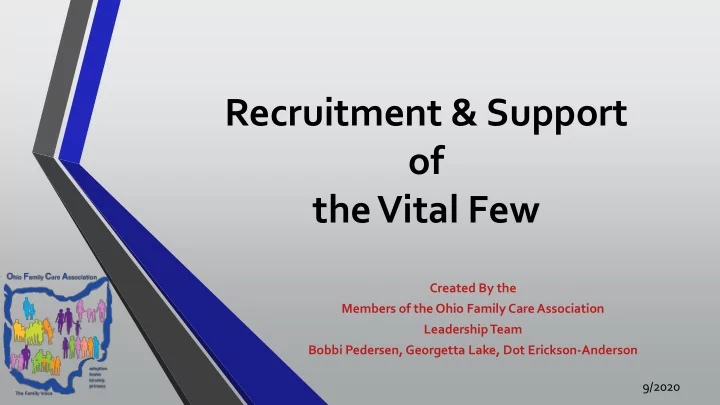

Recruitment & Support of the Vital Few Created By the Members of the Ohio Family Care Association Leadership Team Bobbi Pedersen, Georgetta Lake, Dot Erickson-Anderson 9/2020
• Agencies with a foster care service: 260 • 173 FFH • 103 Tx Where • Licensed Foster Parents: 7,930 Are We • Licensed this past year: 3,196 Now? • Licensed Homes with “placed child”: 4,589 2020 ODJFS data
• Racial Mix of Caregivers & Youth • 2018 Ohio Race of children in care • White = 53% What We • Black/MultiRacial = 41% Also • Race of Families Licensed past year Know • White – 80% • Black/MultiRacial = 19% 2019 AFCARS report; 2020 SACWIS data
We Acknowledge that the child welfare system was built to “save white children from poverty.” See Handout
Is this a Dream or A Path Forward for Our Time?
Who are the Vital Few? Families that can Families that work with children commit to and families with involvement for 5- complex problems 10 years
Review of 17 Families involved in 1970s-80s • 23% Black, 73% white • 42% Single Parents; 36% Married parents; 24% nonparents • 77% had college degrees • 59% left other jobs to join the network • 42% were adoptive parents or became adoptive parents through their experiences
What led to Involvement?
• A job/professional role that made it possible to 'work from home’ • Excited about the prospect of changing what we saw as dysfunctional child welfare & juvenile justice systems • Affirmed the concern for children/youth within the context of family • Being In Mission
What Sustained you for the Years of Your Involvement?
Regular connection with the other families involved in the team Ability of the team to design creative/new ways of dealing with issues - control over budget issues Availability of a wide range of respite -- in home and out of home Growth within myself, my spouse, my permanent children and families in care.
• Participants stayed involved from 4-11 years. 4 remained foster parents 20+ years • 5 returned to private practice (counseling, attorney, child welfare program) What Did You • 2 became Agency Directors Do Next? • 2 Retired • 2 took leadership roles in community programs • 1 became a full-time trainer • 1 became a clergy person
Recruitment is easy When you have something to offer!
Support works when the families have control to determine what they need and how to supply it.
To Start Our Thinking
Evidenced-based focus Mentoring System Navigators "Having a Voice" Building Skills Training Support Recognition or Rewards
What policies and practices would we need to change to recruit and support parents for the future?
• Roles of agency and team in decision Must ensure making • Placement of Children that children have frequent • Role of Primary Family contact with • Culture Issues families and • Proximity & Meeting that their • Programming relationship is • Finances / Breaks from Kids strengthened. • System of Accountability
• Role of terminology Resource Family, Permanency, Primary Family, Interdependent Living • Identify the resource family as a consultant to the agency in the reunification and support services to families Future in crisis Directions To • Training focus change to communication across Think About differences, conflict resolution, crisis interventions, cultural differences (race & income), developing community. • Resource Reallocation See handout
Thank You for Thinking about Needed Change
Recommend
More recommend